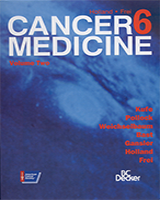By agreement with the publisher, this book is accessible by the search feature, but cannot be browsed.
NCBI Bookshelf. A service of the National Library of Medicine, National Institutes of Health.
Kufe DW, Pollock RE, Weichselbaum RR, et al., editors. Holland-Frei Cancer Medicine. 6th edition. Hamilton (ON): BC Decker; 2003.

Holland-Frei Cancer Medicine. 6th edition.
Show detailsOne of the most notable clinical characteristics of melanoma is its capricious clinical course. It is usually not difficult to determine prognosis for patients with distant metastatic disease, but outcome is far less clearly defined in the majority of patients with clinically localized melanoma. A number of variables have prognostic value, including the patient's age and sex, and the primary tumor's anatomic location, size, Clark's level, Breslow's thickness, and histopathologic type, as well as the status and number of subclinically involved regional lymph nodes.43 A recent review of a multicenter database of 13,581 patients with localized disease demonstrated that tumor thickness and ulceration were most predictive of survival,43a and its findings formed the basis of the new AJCC staging system (see Table 122-2).42 The prognosis for thin, nonulcerated melanomas is excellent (Table 122-3).42a
Table 122-3
Survival According to the New AJCC Staging System.
Ulceration
Ulceration of the primary melanoma is associated with a biologically more aggressive lesion and a poorer prognosis.44 Balch and colleagues reported that 5-year survival rate dropped from 80% for nonulcerated melanomas to 55% for ulcerated melanomas.45 It is not known why ulcerated primaries have a more aggressive biologic nature. It is not likely due to underestimation of the thickness due to the ulcer crater. Ulcerated lesions tend to be thicker and have a nodular growth pattern, but the increased thickness does not account for the poorer prognosis. However, the width of surface ulceration has been significantly correlated with survival. 45
Other Histologic Prognosticators
The mitotic rate per square millimeter and the presence or absence of lymphatic or blood vessel invasion are relevant to prognosis.44 The histologic growth pattern also has prognostic value; LMM may have a more favorable prognosis than SSM or NM.46 Most of these differences may, however, merely reflect a tendency for NM to be thicker and more invasive from inception, whereas LMM tends to be thinner and exhibit a prolonged radial growth phase.
A faint white halo surrounding a cutaneous melanoma may represent regression of the lesion. Microscopically, partial (> 50%) regression is seen as subtotal loss of the melanocyte nest and replacement with lymphocytes. Although regression is generally associated with thin primaries, these lesions have a less favorable outcome than would be expected on the basis of their thickness alone.47–49 The development of new molecular biology techniques may soon allow genetic characteristics to replace histologic features as the most important prognostic indicators.26, 50, 51
Gender
A number of studies have demonstrated that women with melanoma fare substantially better than men.52–54 The survival advantage enjoyed by women may be primarily due to the location of the lesion, which is more commonly on the extremity, and the less frequent presence of ulceration.
Anatomic Site
Anatomic site is an important prognostic factor. Several studies using multifactorial analysis suggest that the anatomic site of the primary lesion is an important prognostic factor.52, 53, 55 Both male and female patients with melanomas of the extremities have a better survival rate than patients with melanomas of the head and neck; patients with melanomas of the trunk appear to have the worst prognosis.56
Day and colleagues identified a group of patients with thin melanomas, apparently at low risk for developing recurrent disease, who nonetheless had unanticipated higher mortality.57 These patients had primary lesions on the skin of the upper back, posterior arm, neck, and scalp. The acronym BANS (back, arm, neck, scalp) was introduced to suggest that these particular anatomic sites had prognostic value. Others have suggested that melanoma arising on the trunk and the head and neck is associated with a poor prognosis.58 The John Wayne Cancer Institute (JWCI) found that patients with primary lesions arising in the BANS region appeared to have a slightly worse outcome than those with lesions in non-BANS regions, particularly in the presence of nodal metastases.59 These results support the hypothesis that lesions arising in these anatomic sites may be more aggressive. Cascinelli and colleagues, however, have questioned the validity of the BANS concept.60
Pregnancy
It has been widely held that melanoma arising during pregnancy is associated with a particularly aggressive clinical course and an extremely grave prognosis. However, a study from JWCI found that women whose melanoma arose during pregnancy were not significantly different from their nonpregnant cohorts in characteristics recognized as being prognostic in melanoma.61 The 5-year survival of female patients of child-bearing age with localized melanoma was 87%, nearly identical to the 86% 5-year survival of their pregnant counterparts. Similar results have been reported by others,62 and a study from the World Health Organization (WHO) found that female melanoma patients presenting during pregnancy had slightly deeper melanomas but not a different prognosis.63 Anecdotal reports of rapid progression of melanoma when associated with pregnancy may represent valid observations but should not guide recommendations for therapy.64
- Prognostic Features of Clinically Localized Disease - Holland-Frei Cancer Medici...Prognostic Features of Clinically Localized Disease - Holland-Frei Cancer Medicine
Your browsing activity is empty.
Activity recording is turned off.
See more...